Impact Mills Market
Impact Mills Market Size and Share Forecast Outlook 2025 to 2035
Impact mills market is projected to grow from USD 940.0 million in 2025 to USD 1,420.0 million by 2035, at a CAGR of 4.2%. Hammer/Impact will dominate with a 60.0% market share, while minerals will lead the application segment with a 35.0% share.
Impact Mills Market Forecast and Outlook 2025 to 2035
The global impact mills market is projected to grow from USD 940.0 million in 2025 to approximately USD 1,420.0 million by 2035, recording an absolute increase of USD 480.0 million over the forecast period. This translates into a total growth of 51.1%, with the market forecast to expand at a compound annual growth rate (CAGR) of 4.2% between 2025 and 2035.
The overall market size is expected to grow by nearly 1.5X during the same period, supported by increasing global demand for efficient size reduction technologies, growing adoption of impact mills in mineral processing applications, and rising industrial production driving advanced milling equipment procurement across various manufacturing and processing applications.
Quick Stats for Impact Mills Market
- Impact Mills Market Value (2025): USD 940.0 million
- Impact Mills Market Forecast Value (2035): USD 1,420.0 million
- Impact Mills Market CAGR: 4.2%
- Leading Segment by Type (2025): Hammer/Impact (60.0%)
- Leading Segment by Application (2025): Minerals (35.0%)
- Leading Segment by Capacity (2025): 1–5 t/h (50.0%)
- Key Growth Regions: Asia Pacific, North America, and Europe
- Top Companies by Market Share: Metso, FLSmidth, Hosokawa
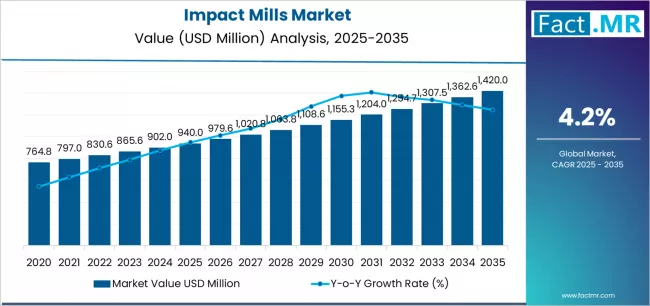
Mining industry professionals express growing frustration with traditional crushing methods when processing brittle materials, driving increased evaluation of impact mill technologies despite concerns about wear rates and maintenance intervals. Mineral processing plant operators report difficulties achieving consistent particle size distribution with conventional equipment, particularly when handling materials with varying hardness characteristics that require frequent equipment adjustments. Production supervisors describe ongoing challenges balancing throughput demands against product quality specifications, creating tension between operational efficiency goals and customer satisfaction requirements.
Equipment selection processes involve extensive cross-functional collaboration between process engineers, maintenance teams, and financial analysts, each bringing conflicting priorities that complicate decision-making timelines. Maintenance personnel emphasize rotor assembly accessibility and liner replacement procedures as critical factors influencing total ownership costs, often disagreeing with engineering teams focused on processing performance metrics. Plant managers express concern about operator training requirements for impact mill systems, citing complexity differences compared to traditional jaw crushers and cone crushers that require specialized knowledge for optimal performance.
Operational difficulties center on abrasive wear management and component replacement scheduling that disrupts production planning processes. Plant operators report unexpected downtime when processing harder materials exceeds anticipated wear rates, requiring inventory adjustments and maintenance procedure modifications. Quality control personnel note particle shape variations when rotor configurations become worn, necessitating frequent monitoring protocols and replacement part staging that increases operational complexity.
Supply chain relationships demonstrate increasing complexity as equipment manufacturers expand global operations while maintaining quality standards across diverse manufacturing locations. Customers report inconsistent component quality between production facilities, creating preference hierarchies for equipment sourced from specific manufacturing sites. Regional service capabilities vary significantly between suppliers, with some providing comprehensive technical support while others rely on local distributors lacking specialized expertise.
Technological advancements in impact mill design, including improved rotor dynamics, wear-resistant materials, and automation integration, are expected to enhance operational efficiency and reduce maintenance frequency. Additionally, the adoption of predictive maintenance systems, real-time monitoring, and digital process controls allows operators to optimize performance, minimize downtime, and ensure consistent product quality. Emerging markets in Asia Pacific and Latin America are driving growth due to expanding mineral processing capacity and industrialization, while mature markets in North America and Europe focus on retrofitting legacy systems for energy efficiency and performance upgrades. Service support, training, and spare part availability remain critical for long-term market adoption.
Impact Mills Market Key Takeaways
| Metric | Value |
|---|---|
| Market Value (2025) | USD 940.0 million |
| Market Forecast Value (2035) | USD 1,420.0 million |
| Forecast CAGR (2025-2035) | 4.2% |
Why is the Impact Mills Market Growing?
| INDUSTRIAL & PRODUCTION TRENDS | MANUFACTURING REQUIREMENTS | TECHNICAL & EFFICIENCY STANDARDS |
|---|---|---|
| Global Industrial Growth Continuing expansion of manufacturing and processing activities across established and emerging markets driving demand for efficient size reduction equipment solutions. Mining Industry Development Growing emphasis on mineral extraction and processing efficiency creating demand for advanced impact mill technologies. Infrastructure Development Superior particle size reduction properties and operational reliability characteristics making impact mills essential for construction materials and industrial applications. | Advanced Processing Requirements Modern manufacturing requires high-performance impact mills delivering precise particle size control and enhanced processing efficiency. Processing Efficiency Demands Manufacturers investing in premium impact mills offering consistent performance while maintaining operational efficiency. Quality and Reliability Standards Certified producers with proven track records required for advanced impact mill applications. | Equipment Performance Standards Regulatory requirements establishing performance benchmarks favoring high-quality impact milling equipment. Quality Property Standards Quality standards requiring superior size reduction capabilities and resistance to operational stresses in processing. Industrial Compliance Requirements Diverse processing requirements and quality standards driving need for advanced impact mill equipment inputs. |
Impact Mills Market Segmentation
| Category | Segments Covered |
|---|---|
| By Type | Hammer/Impact, Shredding Impact, High-speed |
| By Application | Minerals, Biomass, Polymers, Food |
| By Capacity | <1 t/h, 1–5 t/h, >5 t/h |
| By Region | North America, Europe, Asia Pacific, Latin America, Middle East & Africa |
Impact Mills Market Analysis by Type
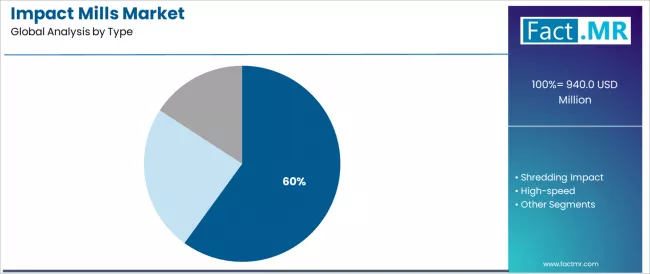
| Segment | 2025 to 2035 Outlook |
|---|---|
| Hammer/Impact | Leader in 2025 with 60.0% market share; likely to maintain leadership through 2035. Broadest use (minerals, biomass, construction), mature supply chain, predictable functionality. Momentum: steady-to-strong. Watchouts: raw material price volatility. |
| Shredding Impact | Cost-effective and well-established for material processing applications, but processing complexity limits broader adoption in specialized industrial applications. Momentum: steady in traditional processing; flat to slightly up in premium segments. |
| High-speed | Benefiting from advanced processing requirements due to specialized particle size control properties and enhanced performance characteristics. Momentum: rising. Watchouts: manufacturing complexity, technical qualification requirements. |
Impact Mills Market Analysis by Application
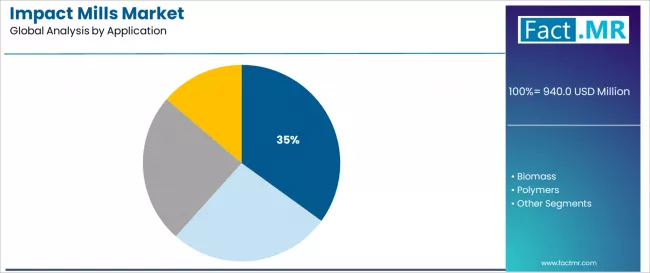
| Segment | 2025 to 2035 Outlook |
|---|---|
| Minerals | At 35.0%, largest application segment in 2025 with established impact mill integration. Mature supply chains, standardized processing specifications. Momentum: steady growth driven by mining industry expansion and premium equipment demand. Watchouts: regulatory changes affecting processing requirements. |
| Biomass | Strong growth segment driven by renewable energy and processing demand. Hammer/Impact and shredding impact mills dominate applications. Momentum: strong growth through 2030, supported by environmental awareness. Watchouts: competition from alternative processing technologies. |
| Polymers | Specialized segment with diverse impact mill requirements. Growing demand for polymer processing supporting higher-value industrial applications. Momentum: moderate growth via manufacturing expansion and processing innovation. Watchouts: regulatory requirements affecting polymer processing. |
| Food | Important segment with specific food-grade processing requirements. Growing demand for food processing supporting manufacturing operations. Momentum: moderate growth via food industry expansion and quality standards. Watchouts: strict hygiene and safety regulations. |
Impact Mills Market Analysis by Capacity
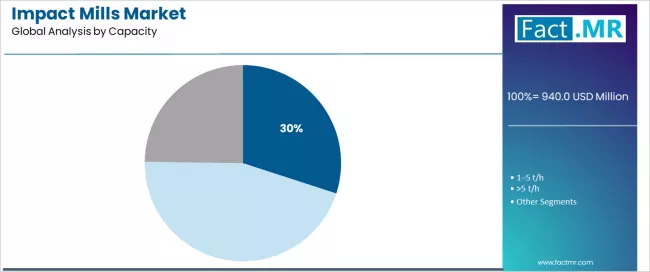
| Capacity | Status & Outlook 2025-2035 |
|---|---|
| <1 t/h | Important segment for specialized applications with 30.0% share in 2025. Laboratory and small-scale operations, processing advantages, ease of operation. Momentum: steady growth driven by specialized applications. Watchouts: limited scalability for large operations. |
| 1–5 t/h | Dominant capacity range in 2025 with 50.0% share for medium-scale applications. Optimal balance between throughput and operational efficiency. Momentum: steady growth driven by industrial expansion and processing advantages. Watchouts: competition from larger capacity systems. |
| >5 t/h | High-capacity segment for large-scale operations requiring maximum throughput. Value-add through superior processing capabilities and operational efficiency. Momentum: moderate growth as large operations demand enhanced performance. Processing complexity may limit broader adoption. |
DRIVERS
| DRIVERS | RESTRAINTS | KEY TRENDS |
|---|---|---|
| Industrial Production Growth Continuing expansion of manufacturing and processing activities across established and emerging markets driving demand for efficient size reduction equipment solutions. Mining Sector Expansion Increasing adoption of advanced milling technologies in mineral processing and extraction operations. Infrastructure Development Growing demand for impact mills that support both performance benefits and processing efficiency in construction and industrial manufacturing. | Equipment Cost Volatility Price fluctuations affecting production costs and supply chain predictability for manufacturers. Manufacturing Complexity Complex technical requirements across applications affecting product development and standardization. Technical Qualification Requirements Complex technical requirements across applications affecting product development and standardization. Competition from Alternatives Alternative size reduction technologies affecting market selection and development. | Advanced Processing Technologies Integration of advanced impact mill processing systems, manufacturing innovations, and quality control solutions enabling superior operational efficiency. Performance Enhancement Enhanced size reduction control, improved operational reliability, and advanced processing capabilities compared to traditional milling systems. Specialized Equipment Development of specialized impact mill grades and custom configurations providing enhanced performance benefits and application-specific optimization. Technical Innovation Integration of advanced impact mill development and intelligent processing management for refined industrial solutions. |
Analysis of Impact Mills Market by Key Countries
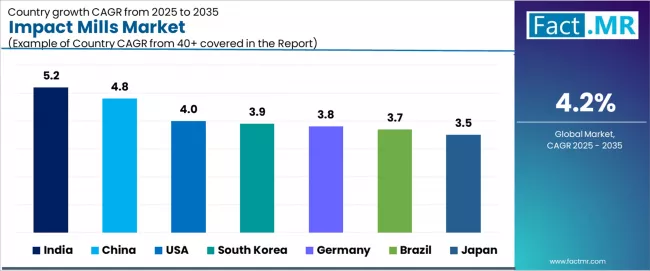
| Country | CAGR (2025-2035) |
|---|---|
| India | 5.2% |
| China | 4.8% |
| USA | 4.0% |
| South Korea | 3.9% |
| Germany | 3.8% |
| Brazil | 3.7% |
| Japan | 3.5% |
India Leads Global Market Growth with Industrial Excellence
Revenue from impact mills in India is projected to exhibit strong growth driven by expanding manufacturing infrastructure and comprehensive industrial processing innovation creating opportunities for equipment suppliers across mineral processing operations, biomass applications, and specialized manufacturing sectors. The country's developing industrial manufacturing tradition and expanding processing capabilities are creating demand for both conventional and high-performance impact mill equipment. Major processing companies are establishing comprehensive local manufacturing facilities to support large-scale operations and meet growing demand for efficient milling solutions.
Industrial modernization programs are supporting widespread adoption of advanced impact mill processing across manufacturing operations, driving demand for high-quality milling equipment. Processing excellence initiatives and specialized equipment development are creating opportunities for suppliers requiring reliable performance and cost-effective impact mill solutions. Manufacturing growth and processing development are facilitating adoption of specialty impact mill equipment throughout major industrial regions.
China Demonstrates Strong Market Potential with Manufacturing Growth
Revenue from impact mills in China is expanding supported by extensive manufacturing expansion and comprehensive industrial processing development creating demand for reliable impact mill equipment across diverse manufacturing categories and specialized processing segments. The country's dominant manufacturing position and expanding industrial capabilities are driving demand for impact mill solutions that provide consistent performance while supporting cost-effective processing requirements. Industrial processors and manufacturers are investing in local production facilities to support growing manufacturing operations and processing demand.
Manufacturing operations expansion and industrial processing capability development are creating opportunities for impact mill equipment across diverse manufacturing segments requiring reliable performance and competitive processing costs. Manufacturing modernization and processing technology advancement are driving investments in industrial supply chains supporting performance requirements throughout major manufacturing regions. Industrial manufacturing growth and specialized processing development programs are enhancing demand for processing-grade impact mills throughout production areas.
USA Maintains Strong Position with Advanced Manufacturing Innovation
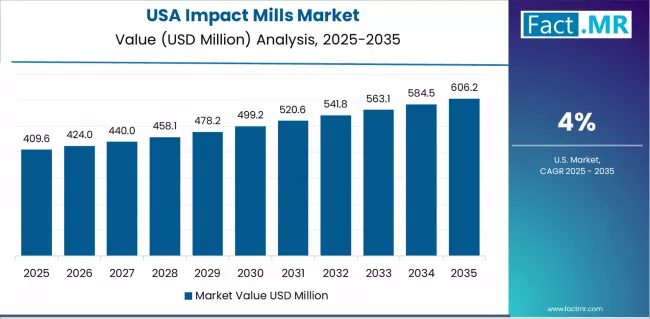
Demand for impact mills in USA is projected to grow supported by the country's expanding industrial manufacturing base and processing technologies requiring advanced impact mill systems for production and specialized applications. American manufacturing companies are implementing processing systems that support advanced manufacturing techniques, operational efficiency, and comprehensive quality protocols. The market is characterized by focus on operational excellence, processing performance, and compliance with industrial quality standards.
Advanced manufacturing industry investments are prioritizing processing technologies that demonstrate superior performance and quality while meeting American manufacturing standards. Processing leadership programs and operational excellence initiatives are driving adoption of precision-engineered impact mill equipment that support advanced manufacturing systems and performance optimization. Research and development programs for processing enhancement are facilitating adoption of specialized processing techniques throughout major industrial centers.
South Korea Focuses on Advanced Manufacturing Processing
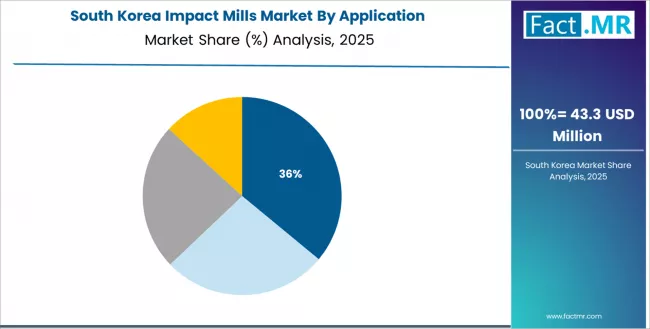
Demand for impact mills in South Korea is projected to grow at 3.9% CAGR driven by advanced manufacturing excellence and specialty impact mill capabilities supporting industrial development and comprehensive processing applications. The country's established manufacturing tradition and growing industrial market segments are creating demand for high-quality impact mill equipment that support operational performance and processing standards.
Advanced manufacturing and specialty impact mill programs are supporting demand for processing-grade impact mills that meet contemporary performance and reliability standards. Industrial development and performance-focused manufacturing programs are creating opportunities for specialized impact mill equipment that provide comprehensive processing support. Manufacturing modernization and quality enhancement programs are facilitating adoption of advanced processing capabilities throughout major manufacturing regions.
Germany Focuses on Premium Manufacturing Processing
Demand for impact mills in Germany is projected to grow driven by precision manufacturing excellence and specialty impact mill capabilities supporting advanced industrial development and comprehensive technical applications. The country's established manufacturing tradition and growing performance industrial market segments are creating demand for high-quality impact mill equipment that support operational performance and processing standards.
Premium manufacturing and specialty impact mill programs are supporting demand for processing-grade impact mills that meet contemporary performance and reliability standards. Industrial development and performance-focused manufacturing programs are creating opportunities for specialized impact mill equipment that provide comprehensive processing support. Manufacturing modernization and quality enhancement programs are facilitating adoption of advanced processing capabilities throughout major manufacturing regions.
Brazil Focuses on Industrial Manufacturing Growth
Demand for impact mills in Brazil is projected to grow driven by expanding manufacturing excellence and specialty impact mill capabilities supporting industrial development and comprehensive processing applications. The country's developing manufacturing base and growing industrial market segments are creating demand for impact mill equipment that support operational performance and processing standards.
Industrial manufacturing and specialty impact mill programs are supporting demand for processing-grade impact mills that meet performance and reliability standards. Manufacturing development and processing programs are creating opportunities for specialized impact mill equipment that provide processing support. Manufacturing modernization and industrial enhancement programs are facilitating adoption of processing capabilities throughout major industrial regions.
Japan Focuses on Precision Manufacturing Processing
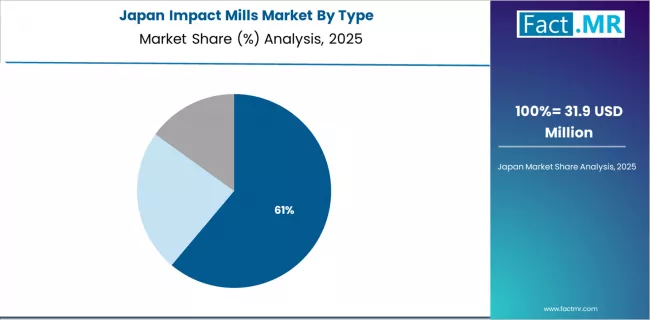
Demand for impact mills in Japan is projected to grow driven by precision manufacturing excellence and specialty impact mill capabilities supporting advanced industrial development and comprehensive technical applications. The country's established manufacturing tradition and growing performance industrial market segments are creating demand for high-quality impact mill equipment that support operational performance and processing standards.
Precision manufacturing and specialty impact mill programs are supporting demand for processing-grade impact mills that meet contemporary performance and reliability standards. Industrial development and performance-focused manufacturing programs are creating opportunities for specialized impact mill equipment that provide comprehensive processing support. Manufacturing modernization and quality enhancement programs are facilitating adoption of advanced processing capabilities throughout major industrial regions.
Europe Market Split by Processing Application
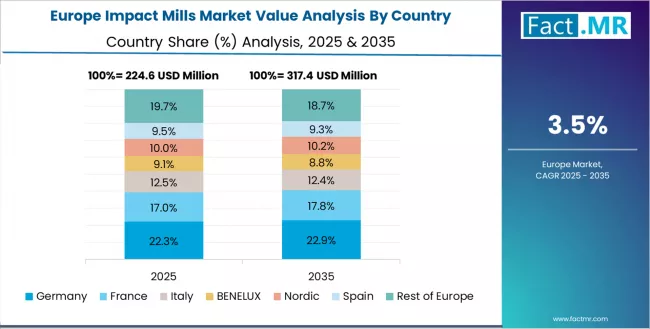
European impact mill operations are increasingly polarized between Western European precision processing and Eastern European cost-competitive manufacturing. German (USD 200.0 million) and UK facilities (USD 140.0 million) dominate premium industrial and manufacturing impact mill processing, leveraging advanced processing technologies and strict quality protocols that command price premiums in global markets. German processors maintain leadership in high-performance impact mill applications, with major manufacturing companies driving technical specifications that smaller suppliers must meet to access supply contracts.
France (USD 120.0 million), Italy (USD 95.0 million), and Spain (USD 80.0 million) operations focus on specialized applications and regional market requirements. Rest of Europe (USD 205.0 million) including Eastern European operations in Poland, Hungary, and Czech Republic are capturing volume-oriented processing contracts through labor cost advantages and EU regulatory compliance, particularly in standard impact mill equipment for manufacturing applications.
The regulatory environment presents both opportunities and constraints. EU machinery regulations and industrial equipment directives create barriers for novel impact mill equipment but establish quality standards that favor established European processors over imports. Brexit has fragmented UK sourcing from EU suppliers, creating opportunities for direct relationships between processors and British manufacturers.
Supply chain consolidation accelerates as processors seek economies of scale to absorb rising energy costs and compliance expenses. Vertical integration increases, with major manufacturers acquiring processing facilities to secure impact mill supplies and quality control. Smaller processors face pressure to specialize in niche applications or risk displacement by larger, more efficient operations serving mainstream manufacturing requirements.
Premium Quality Standards Define Japanese Market Dynamics
Japanese Impact Mills operations reflect the country's exacting quality standards and refined industrial expectations. Major manufacturing companies maintain rigorous supplier qualification processes that often exceed international standards, requiring extensive documentation, batch testing, and facility audits that can take 12-18 months to complete. This creates high barriers for new suppliers but ensures consistent quality that supports premium product positioning.
The Japanese market demonstrates unique application preferences with Minerals accounting for 40.0%, Biomass 30.0%, Polymers 20.0%, and Food 10.0%. Companies require specific size reduction specifications and performance standards that differ from Western applications, driving demand for customized processing capabilities.
Japanese market demonstrates unique type preferences with Hammer/Impact accounting for 60.0%, Shredding Impact 25.0%, and High-speed 15.0%. Companies require specific performance characteristics and reliability specifications that differ from Western applications, driving demand for customized processing capabilities.
Regulatory oversight emphasizes comprehensive equipment management and traceability requirements that surpass most international standards. The equipment registration system requires detailed component sourcing information, creating advantages for suppliers with transparent supply chains and comprehensive documentation systems.
Supply chain management focuses on relationship-based partnerships rather than purely transactional procurement. Japanese companies typically maintain long-term supplier relationships spanning decades, with annual contract negotiations emphasizing quality consistency over price competition. This stability supports investment in specialized processing equipment tailored to Japanese specifications.
Market Dynamics Drive Innovation in South Korea
South Korean Impact Mills operations reflect the country's advanced manufacturing sector and export-oriented business model. Major manufacturing companies drive refined equipment procurement strategies, establishing direct relationships with global suppliers to secure consistent quality and pricing for their industrial and processing operations targeting both domestic and international markets.
The Korean market demonstrates strength in type distribution with Hammer/Impact accounting for 65.0%, Shredding Impact 20.0%, and High-speed 15.0%. This manufacturing-focused approach creates demand for specific performance specifications that differ from Western applications, requiring suppliers to adapt processing and quality techniques.
Regulatory frameworks emphasize equipment safety and traceability, with Korean industrial administration standards often exceeding international requirements. This creates barriers for smaller equipment suppliers but benefits established processors who can demonstrate compliance capabilities. The regulatory environment particularly favors suppliers with comprehensive certification and documentation systems.
Supply chain efficiency remains critical given Korea's geographic limitations and import dependence. Companies increasingly pursue long-term contracts with suppliers in United States, Germany, and Japan to ensure reliable access to equipment while managing foreign exchange risks. Technical logistics investments support quality preservation during extended shipping periods.
The market faces pressure from rising labor costs and competition from lower-cost regional manufacturers, driving automation investments and consolidation among smaller processors. The premium positioning of Korean manufacturing internationally continues to support demand for high-quality impact mill equipment that meet stringent specifications.
Competitive Landscape of Impact Mills Market
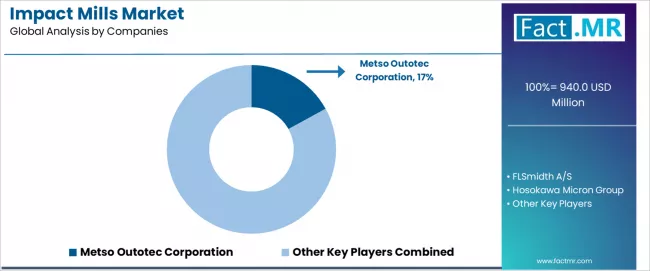
Profit pools are consolidating upstream in scaled impact mill production systems and downstream in value-added specialty equipment for minerals, biomass, and polymer processing applications where certification, traceability, and consistent performance command premiums. Value is migrating from raw equipment commodity trading to specification-tight, application-ready impact mills where technical expertise and quality control drive competitive advantage.
Several archetypes set the pace: global industrial integrators defending share through production scale and technical reliability; multi-capacity processors that manage complexity and serve diverse applications; specialty impact mill developers with engineering expertise and manufacturing industry ties; and performance-driven suppliers pulling volume in premium processing and industrial applications. Switching costs—re-qualification, performance testing, operational validation, provide stability for incumbents, while supply shocks and regulatory changes reopen opportunities for diversified suppliers.
Consolidation and verticalization continue; digital procurement emerges in commodity grades while premium specifications remain relationship-led. Focus areas: lock manufacturing and processing pipelines with application-specific equipment and service level agreements; establish multi-capacity production capabilities and technical disclosure; develop specialized impact mill configurations with performance claims.
| Stakeholder Type | Primary Advantage | Repeatable Plays |
|---|---|---|
| Global industrial integrators | Scale, production integration, technical reliability | Long-term contracts, tight specs, co-development with manufacturing/processing |
| Multi-capacity processors | Capacity diversification, application expertise, supply flexibility | Multi-application serving, technical support, quality assurance across segments |
| Specialty impact mill developers | Engineering expertise and industry relationships | Custom configurations, performance science, operational SLAs |
| Performance suppliers | Application-focused demand and specialized service | Technical performance claims, specialized equipment, application activation |
| Industrial distributors & platforms | Technical support for mid-tier manufacturers | Equipment selection, smaller volumes, technical service |
Key Players in the Impact Mills Market
- Metso Outotec Corporation
- FLSmidth A/S
- Hosokawa Micron Group
- Williams Patent Crusher & Pulverizer Co., Inc.
- CPM Holdings, Inc.
- Schutte-Buffalo Hammermill, Inc.
- Jeffrey Rader Corporation
- BHS-Sonthofen GmbH
- Netzsch Group
- Hosokawa Alpine AG
- KHD Humboldt Wedag International AG
- Allgaier Process Technology GmbH
- IFE GmbH
- Stedman Machine Company, Inc.
- CEMCO, Inc.
Scope of the Report
| Items | Values |
|---|---|
| Quantitative Units (2025) | USD 940.0 Million |
| Product | Hammer/Impact, Shredding Impact, High-speed |
| Application | Minerals, Biomass, Polymers, Food |
| Capacity | <1 t/h, 1–5 t/h, >5 t/h |
| Regions Covered | North America, Europe, Asia Pacific, Latin America, Middle East & Africa |
| Countries Covered | United States, Germany, China, Japan, India, South Korea, Brazil, and other 40+ countries |
| Key Companies Profiled | Metso, FLSmidth, Hosokawa, Williams Patent Crusher, CPM, Schutte-Buffalo, Jeffrey Rader, BHS-Sonthofen, Netzsch, Hosokawa Alpine, KHD, Allgaier, IFE, Stedman, CEMCO |
| Additional Attributes | Dollar sales by product/application/capacity, regional demand (NA, EU, APAC), competitive landscape, capacity adoption, production/processing integration, and advanced processing innovations driving performance enhancement, technical advancement, and efficiency |
Impact Mills Market Segmentation
-
By Type :
- Hammer/Impact
- Shredding Impact
- High-speed
-
By Application :
- Minerals
- Biomass
- Polymers
- Food
-
By Capacity :
- <1 t/h
- 1–5 t/h
- 5 t/h
-
By Region :
- North America
- Europe
- Asia Pacific
- Latin America
- Middle East & Africa
Table of Content
- Executive Summary
- Global Market Outlook
- Demand to side Trends
- Supply to side Trends
- Technology Roadmap Analysis
- Analysis and Recommendations
- Market Overview
- Market Coverage / Taxonomy
- Market Definition / Scope / Limitations
- Market Background
- Market Dynamics
- Drivers
- Restraints
- Opportunity
- Trends
- Scenario Forecast
- Demand in Optimistic Scenario
- Demand in Likely Scenario
- Demand in Conservative Scenario
- Opportunity Map Analysis
- Product Life Cycle Analysis
- Supply Chain Analysis
- Investment Feasibility Matrix
- Value Chain Analysis
- PESTLE and Porter’s Analysis
- Regulatory Landscape
- Regional Parent Market Outlook
- Production and Consumption Statistics
- Import and Export Statistics
- Market Dynamics
- Global Market Analysis 2020 to 2024 and Forecast, 2025 to 2035
- Historical Market Size Value (USD Million) Analysis, 2020 to 2024
- Current and Future Market Size Value (USD Million) Projections, 2025 to 2035
- Y to o to Y Growth Trend Analysis
- Absolute $ Opportunity Analysis
- Global Market Pricing Analysis 2020 to 2024 and Forecast 2025 to 2035
- Global Market Analysis 2020 to 2024 and Forecast 2025 to 2035, By Type
- Introduction / Key Findings
- Historical Market Size Value (USD Million) Analysis By Type , 2020 to 2024
- Current and Future Market Size Value (USD Million) Analysis and Forecast By Type , 2025 to 2035
- Hammer/Impact
- Shredding Impact
- High-speed
- Y to o to Y Growth Trend Analysis By Type , 2020 to 2024
- Absolute $ Opportunity Analysis By Type , 2025 to 2035
- Global Market Analysis 2020 to 2024 and Forecast 2025 to 2035, By Application
- Introduction / Key Findings
- Historical Market Size Value (USD Million) Analysis By Application, 2020 to 2024
- Current and Future Market Size Value (USD Million) Analysis and Forecast By Application, 2025 to 2035
- Minerals
- Biomass
- Polymers
- Food
- Y to o to Y Growth Trend Analysis By Application, 2020 to 2024
- Absolute $ Opportunity Analysis By Application, 2025 to 2035
- Global Market Analysis 2020 to 2024 and Forecast 2025 to 2035, By Capacity
- Introduction / Key Findings
- Historical Market Size Value (USD Million) Analysis By Capacity, 2020 to 2024
- Current and Future Market Size Value (USD Million) Analysis and Forecast By Capacity, 2025 to 2035
- <1 t/h
- 1–5 t/h
- >5 t/h
- Y to o to Y Growth Trend Analysis By Capacity, 2020 to 2024
- Absolute $ Opportunity Analysis By Capacity, 2025 to 2035
- Global Market Analysis 2020 to 2024 and Forecast 2025 to 2035, By Region
- Introduction
- Historical Market Size Value (USD Million) Analysis By Region, 2020 to 2024
- Current Market Size Value (USD Million) Analysis and Forecast By Region, 2025 to 2035
- North America
- Latin America
- Western Europe
- Eastern Europe
- East Asia
- South Asia and Pacific
- Middle East & Africa
- Market Attractiveness Analysis By Region
- North America Market Analysis 2020 to 2024 and Forecast 2025 to 2035, By Country
- Historical Market Size Value (USD Million) Trend Analysis By Market Taxonomy, 2020 to 2024
- Market Size Value (USD Million) Forecast By Market Taxonomy, 2025 to 2035
- By Country
- USA
- Canada
- Mexico
- By Type
- By Application
- By Capacity
- By Country
- Market Attractiveness Analysis
- By Country
- By Type
- By Application
- By Capacity
- Key Takeaways
- Latin America Market Analysis 2020 to 2024 and Forecast 2025 to 2035, By Country
- Historical Market Size Value (USD Million) Trend Analysis By Market Taxonomy, 2020 to 2024
- Market Size Value (USD Million) Forecast By Market Taxonomy, 2025 to 2035
- By Country
- Brazil
- Chile
- Rest of Latin America
- By Type
- By Application
- By Capacity
- By Country
- Market Attractiveness Analysis
- By Country
- By Type
- By Application
- By Capacity
- Key Takeaways
- Western Europe Market Analysis 2020 to 2024 and Forecast 2025 to 2035, By Country
- Historical Market Size Value (USD Million) Trend Analysis By Market Taxonomy, 2020 to 2024
- Market Size Value (USD Million) Forecast By Market Taxonomy, 2025 to 2035
- By Country
- Germany
- UK
- Italy
- Spain
- France
- Nordic
- BENELUX
- Rest of Western Europe
- By Type
- By Application
- By Capacity
- By Country
- Market Attractiveness Analysis
- By Country
- By Type
- By Application
- By Capacity
- Key Takeaways
- Eastern Europe Market Analysis 2020 to 2024 and Forecast 2025 to 2035, By Country
- Historical Market Size Value (USD Million) Trend Analysis By Market Taxonomy, 2020 to 2024
- Market Size Value (USD Million) Forecast By Market Taxonomy, 2025 to 2035
- By Country
- Russia
- Poland
- Hungary
- Balkan & Baltic
- Rest of Eastern Europe
- By Type
- By Application
- By Capacity
- By Country
- Market Attractiveness Analysis
- By Country
- By Type
- By Application
- By Capacity
- Key Takeaways
- East Asia Market Analysis 2020 to 2024 and Forecast 2025 to 2035, By Country
- Historical Market Size Value (USD Million) Trend Analysis By Market Taxonomy, 2020 to 2024
- Market Size Value (USD Million) Forecast By Market Taxonomy, 2025 to 2035
- By Country
- China
- Japan
- South Korea
- By Type
- By Application
- By Capacity
- By Country
- Market Attractiveness Analysis
- By Country
- By Type
- By Application
- By Capacity
- Key Takeaways
- South Asia and Pacific Market Analysis 2020 to 2024 and Forecast 2025 to 2035, By Country
- Historical Market Size Value (USD Million) Trend Analysis By Market Taxonomy, 2020 to 2024
- Market Size Value (USD Million) Forecast By Market Taxonomy, 2025 to 2035
- By Country
- India
- ASEAN
- Australia & New Zealand
- Rest of South Asia and Pacific
- By Type
- By Application
- By Capacity
- By Country
- Market Attractiveness Analysis
- By Country
- By Type
- By Application
- By Capacity
- Key Takeaways
- Middle East & Africa Market Analysis 2020 to 2024 and Forecast 2025 to 2035, By Country
- Historical Market Size Value (USD Million) Trend Analysis By Market Taxonomy, 2020 to 2024
- Market Size Value (USD Million) Forecast By Market Taxonomy, 2025 to 2035
- By Country
- Kingdom of Saudi Arabia
- Other GCC Countries
- Turkiye
- South Africa
- Other African Union
- Rest of Middle East & Africa
- By Type
- By Application
- By Capacity
- By Country
- Market Attractiveness Analysis
- By Country
- By Type
- By Application
- By Capacity
- Key Takeaways
- Key Countries Market Analysis
- USA
- Pricing Analysis
- Market Share Analysis, 2024
- By Type
- By Application
- By Capacity
- Canada
- Pricing Analysis
- Market Share Analysis, 2024
- By Type
- By Application
- By Capacity
- Mexico
- Pricing Analysis
- Market Share Analysis, 2024
- By Type
- By Application
- By Capacity
- Brazil
- Pricing Analysis
- Market Share Analysis, 2024
- By Type
- By Application
- By Capacity
- Chile
- Pricing Analysis
- Market Share Analysis, 2024
- By Type
- By Application
- By Capacity
- Germany
- Pricing Analysis
- Market Share Analysis, 2024
- By Type
- By Application
- By Capacity
- UK
- Pricing Analysis
- Market Share Analysis, 2024
- By Type
- By Application
- By Capacity
- Italy
- Pricing Analysis
- Market Share Analysis, 2024
- By Type
- By Application
- By Capacity
- Spain
- Pricing Analysis
- Market Share Analysis, 2024
- By Type
- By Application
- By Capacity
- France
- Pricing Analysis
- Market Share Analysis, 2024
- By Type
- By Application
- By Capacity
- India
- Pricing Analysis
- Market Share Analysis, 2024
- By Type
- By Application
- By Capacity
- ASEAN
- Pricing Analysis
- Market Share Analysis, 2024
- By Type
- By Application
- By Capacity
- Australia & New Zealand
- Pricing Analysis
- Market Share Analysis, 2024
- By Type
- By Application
- By Capacity
- China
- Pricing Analysis
- Market Share Analysis, 2024
- By Type
- By Application
- By Capacity
- Japan
- Pricing Analysis
- Market Share Analysis, 2024
- By Type
- By Application
- By Capacity
- South Korea
- Pricing Analysis
- Market Share Analysis, 2024
- By Type
- By Application
- By Capacity
- Russia
- Pricing Analysis
- Market Share Analysis, 2024
- By Type
- By Application
- By Capacity
- Poland
- Pricing Analysis
- Market Share Analysis, 2024
- By Type
- By Application
- By Capacity
- Hungary
- Pricing Analysis
- Market Share Analysis, 2024
- By Type
- By Application
- By Capacity
- Kingdom of Saudi Arabia
- Pricing Analysis
- Market Share Analysis, 2024
- By Type
- By Application
- By Capacity
- Turkiye
- Pricing Analysis
- Market Share Analysis, 2024
- By Type
- By Application
- By Capacity
- South Africa
- Pricing Analysis
- Market Share Analysis, 2024
- By Type
- By Application
- By Capacity
- USA
- Market Structure Analysis
- Competition Dashboard
- Competition Benchmarking
- Market Share Analysis of Top Players
- By Regional
- By Type
- By Application
- By Capacity
- Competition Analysis
- Competition Deep Dive
- Metso Outotec Corporation
- Overview
- Product Portfolio
- Profitability by Market Segments (Product/Age /Sales Channel/Region)
- Sales Footprint
- Strategy Overview
- Marketing Strategy
- Product Strategy
- Channel Strategy
- FLSmidth A/S
- Hosokawa Micron Group
- Williams Patent Crusher & Pulverizer Co., Inc.
- CPM Holdings, Inc.
- Schutte-Buffalo Hammermill, Inc.
- Jeffrey Rader Corporation
- BHS-Sonthofen GmbH
- Netzsch Group
- Hosokawa Alpine AG
- KHD Humboldt Wedag International AG
- Allgaier Process Technology GmbH
- IFE GmbH
- Stedman Machine Company, Inc.
- CEMCO, Inc.
- Metso Outotec Corporation
- Competition Deep Dive
- Assumptions & Acronyms Used
- Research Methodology
List Of Table
- Table 1: Global Market Value (USD Million) Forecast by Region, 2020 to 2035
- Table 2: Global Market Value (USD Million) Forecast by Type , 2020 to 2035
- Table 3: Global Market Value (USD Million) Forecast by Application, 2020 to 2035
- Table 4: Global Market Value (USD Million) Forecast by Capacity, 2020 to 2035
- Table 5: North America Market Value (USD Million) Forecast by Country, 2020 to 2035
- Table 6: North America Market Value (USD Million) Forecast by Type , 2020 to 2035
- Table 7: North America Market Value (USD Million) Forecast by Application, 2020 to 2035
- Table 8: North America Market Value (USD Million) Forecast by Capacity, 2020 to 2035
- Table 9: Latin America Market Value (USD Million) Forecast by Country, 2020 to 2035
- Table 10: Latin America Market Value (USD Million) Forecast by Type , 2020 to 2035
- Table 11: Latin America Market Value (USD Million) Forecast by Application, 2020 to 2035
- Table 12: Latin America Market Value (USD Million) Forecast by Capacity, 2020 to 2035
- Table 13: Western Europe Market Value (USD Million) Forecast by Country, 2020 to 2035
- Table 14: Western Europe Market Value (USD Million) Forecast by Type , 2020 to 2035
- Table 15: Western Europe Market Value (USD Million) Forecast by Application, 2020 to 2035
- Table 16: Western Europe Market Value (USD Million) Forecast by Capacity, 2020 to 2035
- Table 17: Eastern Europe Market Value (USD Million) Forecast by Country, 2020 to 2035
- Table 18: Eastern Europe Market Value (USD Million) Forecast by Type , 2020 to 2035
- Table 19: Eastern Europe Market Value (USD Million) Forecast by Application, 2020 to 2035
- Table 20: Eastern Europe Market Value (USD Million) Forecast by Capacity, 2020 to 2035
- Table 21: East Asia Market Value (USD Million) Forecast by Country, 2020 to 2035
- Table 22: East Asia Market Value (USD Million) Forecast by Type , 2020 to 2035
- Table 23: East Asia Market Value (USD Million) Forecast by Application, 2020 to 2035
- Table 24: East Asia Market Value (USD Million) Forecast by Capacity, 2020 to 2035
- Table 25: South Asia and Pacific Market Value (USD Million) Forecast by Country, 2020 to 2035
- Table 26: South Asia and Pacific Market Value (USD Million) Forecast by Type , 2020 to 2035
- Table 27: South Asia and Pacific Market Value (USD Million) Forecast by Application, 2020 to 2035
- Table 28: South Asia and Pacific Market Value (USD Million) Forecast by Capacity, 2020 to 2035
- Table 29: Middle East & Africa Market Value (USD Million) Forecast by Country, 2020 to 2035
- Table 30: Middle East & Africa Market Value (USD Million) Forecast by Type , 2020 to 2035
- Table 31: Middle East & Africa Market Value (USD Million) Forecast by Application, 2020 to 2035
- Table 32: Middle East & Africa Market Value (USD Million) Forecast by Capacity, 2020 to 2035
List Of Figures
- Figure 1: Global Market Pricing Analysis
- Figure 2: Global Market Value (USD Million) Forecast 2020-2035
- Figure 3: Global Market Value Share and BPS Analysis by Type , 2025 and 2035
- Figure 4: Global Market Y to o to Y Growth Comparison by Type , 2025-2035
- Figure 5: Global Market Attractiveness Analysis by Type
- Figure 6: Global Market Value Share and BPS Analysis by Application, 2025 and 2035
- Figure 7: Global Market Y to o to Y Growth Comparison by Application, 2025-2035
- Figure 8: Global Market Attractiveness Analysis by Application
- Figure 9: Global Market Value Share and BPS Analysis by Capacity, 2025 and 2035
- Figure 10: Global Market Y to o to Y Growth Comparison by Capacity, 2025-2035
- Figure 11: Global Market Attractiveness Analysis by Capacity
- Figure 12: Global Market Value (USD Million) Share and BPS Analysis by Region, 2025 and 2035
- Figure 13: Global Market Y to o to Y Growth Comparison by Region, 2025-2035
- Figure 14: Global Market Attractiveness Analysis by Region
- Figure 15: North America Market Incremental Dollar Opportunity, 2025-2035
- Figure 16: Latin America Market Incremental Dollar Opportunity, 2025-2035
- Figure 17: Western Europe Market Incremental Dollar Opportunity, 2025-2035
- Figure 18: Eastern Europe Market Incremental Dollar Opportunity, 2025-2035
- Figure 19: East Asia Market Incremental Dollar Opportunity, 2025-2035
- Figure 20: South Asia and Pacific Market Incremental Dollar Opportunity, 2025-2035
- Figure 21: Middle East & Africa Market Incremental Dollar Opportunity, 2025-2035
- Figure 22: North America Market Value Share and BPS Analysis by Country, 2025 and 2035
- Figure 23: North America Market Value Share and BPS Analysis by Type , 2025 and 2035
- Figure 24: North America Market Y to o to Y Growth Comparison by Type , 2025-2035
- Figure 25: North America Market Attractiveness Analysis by Type
- Figure 26: North America Market Value Share and BPS Analysis by Application, 2025 and 2035
- Figure 27: North America Market Y to o to Y Growth Comparison by Application, 2025-2035
- Figure 28: North America Market Attractiveness Analysis by Application
- Figure 29: North America Market Value Share and BPS Analysis by Capacity, 2025 and 2035
- Figure 30: North America Market Y to o to Y Growth Comparison by Capacity, 2025-2035
- Figure 31: North America Market Attractiveness Analysis by Capacity
- Figure 32: Latin America Market Value Share and BPS Analysis by Country, 2025 and 2035
- Figure 33: Latin America Market Value Share and BPS Analysis by Type , 2025 and 2035
- Figure 34: Latin America Market Y to o to Y Growth Comparison by Type , 2025-2035
- Figure 35: Latin America Market Attractiveness Analysis by Type
- Figure 36: Latin America Market Value Share and BPS Analysis by Application, 2025 and 2035
- Figure 37: Latin America Market Y to o to Y Growth Comparison by Application, 2025-2035
- Figure 38: Latin America Market Attractiveness Analysis by Application
- Figure 39: Latin America Market Value Share and BPS Analysis by Capacity, 2025 and 2035
- Figure 40: Latin America Market Y to o to Y Growth Comparison by Capacity, 2025-2035
- Figure 41: Latin America Market Attractiveness Analysis by Capacity
- Figure 42: Western Europe Market Value Share and BPS Analysis by Country, 2025 and 2035
- Figure 43: Western Europe Market Value Share and BPS Analysis by Type , 2025 and 2035
- Figure 44: Western Europe Market Y to o to Y Growth Comparison by Type , 2025-2035
- Figure 45: Western Europe Market Attractiveness Analysis by Type
- Figure 46: Western Europe Market Value Share and BPS Analysis by Application, 2025 and 2035
- Figure 47: Western Europe Market Y to o to Y Growth Comparison by Application, 2025-2035
- Figure 48: Western Europe Market Attractiveness Analysis by Application
- Figure 49: Western Europe Market Value Share and BPS Analysis by Capacity, 2025 and 2035
- Figure 50: Western Europe Market Y to o to Y Growth Comparison by Capacity, 2025-2035
- Figure 51: Western Europe Market Attractiveness Analysis by Capacity
- Figure 52: Eastern Europe Market Value Share and BPS Analysis by Country, 2025 and 2035
- Figure 53: Eastern Europe Market Value Share and BPS Analysis by Type , 2025 and 2035
- Figure 54: Eastern Europe Market Y to o to Y Growth Comparison by Type , 2025-2035
- Figure 55: Eastern Europe Market Attractiveness Analysis by Type
- Figure 56: Eastern Europe Market Value Share and BPS Analysis by Application, 2025 and 2035
- Figure 57: Eastern Europe Market Y to o to Y Growth Comparison by Application, 2025-2035
- Figure 58: Eastern Europe Market Attractiveness Analysis by Application
- Figure 59: Eastern Europe Market Value Share and BPS Analysis by Capacity, 2025 and 2035
- Figure 60: Eastern Europe Market Y to o to Y Growth Comparison by Capacity, 2025-2035
- Figure 61: Eastern Europe Market Attractiveness Analysis by Capacity
- Figure 62: East Asia Market Value Share and BPS Analysis by Country, 2025 and 2035
- Figure 63: East Asia Market Value Share and BPS Analysis by Type , 2025 and 2035
- Figure 64: East Asia Market Y to o to Y Growth Comparison by Type , 2025-2035
- Figure 65: East Asia Market Attractiveness Analysis by Type
- Figure 66: East Asia Market Value Share and BPS Analysis by Application, 2025 and 2035
- Figure 67: East Asia Market Y to o to Y Growth Comparison by Application, 2025-2035
- Figure 68: East Asia Market Attractiveness Analysis by Application
- Figure 69: East Asia Market Value Share and BPS Analysis by Capacity, 2025 and 2035
- Figure 70: East Asia Market Y to o to Y Growth Comparison by Capacity, 2025-2035
- Figure 71: East Asia Market Attractiveness Analysis by Capacity
- Figure 72: South Asia and Pacific Market Value Share and BPS Analysis by Country, 2025 and 2035
- Figure 73: South Asia and Pacific Market Value Share and BPS Analysis by Type , 2025 and 2035
- Figure 74: South Asia and Pacific Market Y to o to Y Growth Comparison by Type , 2025-2035
- Figure 75: South Asia and Pacific Market Attractiveness Analysis by Type
- Figure 76: South Asia and Pacific Market Value Share and BPS Analysis by Application, 2025 and 2035
- Figure 77: South Asia and Pacific Market Y to o to Y Growth Comparison by Application, 2025-2035
- Figure 78: South Asia and Pacific Market Attractiveness Analysis by Application
- Figure 79: South Asia and Pacific Market Value Share and BPS Analysis by Capacity, 2025 and 2035
- Figure 80: South Asia and Pacific Market Y to o to Y Growth Comparison by Capacity, 2025-2035
- Figure 81: South Asia and Pacific Market Attractiveness Analysis by Capacity
- Figure 82: Middle East & Africa Market Value Share and BPS Analysis by Country, 2025 and 2035
- Figure 83: Middle East & Africa Market Value Share and BPS Analysis by Type , 2025 and 2035
- Figure 84: Middle East & Africa Market Y to o to Y Growth Comparison by Type , 2025-2035
- Figure 85: Middle East & Africa Market Attractiveness Analysis by Type
- Figure 86: Middle East & Africa Market Value Share and BPS Analysis by Application, 2025 and 2035
- Figure 87: Middle East & Africa Market Y to o to Y Growth Comparison by Application, 2025-2035
- Figure 88: Middle East & Africa Market Attractiveness Analysis by Application
- Figure 89: Middle East & Africa Market Value Share and BPS Analysis by Capacity, 2025 and 2035
- Figure 90: Middle East & Africa Market Y to o to Y Growth Comparison by Capacity, 2025-2035
- Figure 91: Middle East & Africa Market Attractiveness Analysis by Capacity
- Figure 92: Global Market - Tier Structure Analysis
- Figure 93: Global Market - Company Share Analysis
- FAQs -
How big is the impact mills market in 2025?
The global impact mills market is estimated to be valued at USD 940.0 million in 2025.
What will be the size of impact mills market in 2035?
The market size for the impact mills market is projected to reach USD 1,420.0 million by 2035.
How much will be the impact mills market growth between 2025 and 2035?
The impact mills market is expected to grow at a 4.2% CAGR between 2025 and 2035.
What are the key product types in the impact mills market?
The key product types in impact mills market are hammer/impact, shredding impact and high-speed.
Which application segment to contribute significant share in the impact mills market in 2025?
In terms of application, minerals segment to command 35.0% share in the impact mills market in 2025.